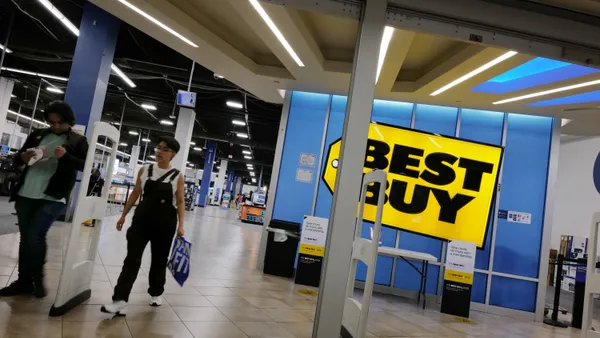Dive Brief:
-
Ralph Lauren's turnaround efforts are leading to sales declines but at the same time are helping its margins inch up, according to its first quarter earnings report. In North America, revenue was down 17%, but expanded gross margin and expense cuts yielded 110 basis points in adjusted operating margin, the company said.
-
Wholesale sales also took a hit in North America as the company strategically reduced shipments to department stores and off-price stores, accounting for almost 20 points of the 27% decline in U.S. wholesale in the quarter, Ralph Lauren CFO Jane Hamilton Nielsen told analysts Thursday, according to a transcript of its conference call from Seeking Alpha.
-
The company is on track to close 20% to 25% of its U.S. department store concessions by the second half of the fiscal year, Nielsen said. Along with its wholesale footprint, the brand has also reduced its inventory by 31% compared to the year-ago period through changes in its buying processes and a pullback in receipts.
Dive Insight:
Ralph Lauren’s “Way Forward” turnaround plan has had trouble gaining traction, suffering a delay as its founder switched up chief executives in the midst of it. That has effectively put the brand at square one after many "false starts," according to GlobalData Retail Managing Director Neil Saunders.
The brand's sales declines appear to be a necessary evil in its attempt to bring up its margins and ditch the faltering department store channel. That's how Wall Street seemed to view it, as shares went up 13% Wednesday. Q1 adjusted earnings were $1.11 per share, beating the 95-cent FactSet consensus cited by Marketwatch. Its revenue in the quarter of $1.35 billion also beat the FactSet expectation for $1.34 billion, though it represented a decline from last year's $1.55 billion.
The pullback from department stores isn't just about margin protection, however — the company has to also bring clarity to the brand, according to Saunders. "To succeed, Ralph Lauren needs to both win back old customers and secure new ones, especially new, younger consumers who do not feel connected with the brand," he said. "As we have noted before, it simply isn't credible for a high-end brand to simultaneously showcase itself in a glitzy store on Madison Avenue while at the same time hawking a random assortment of sweaters thrown in a ragtag way on a table in Macy's."
But, Saunders added, inventory and SKU count reduction, especially among sub-brands and capsule collections, are just as important. "In theory, these are supposed to cater to different constituents of the market," he said. "In practice, there is no real delineation between many of the elements, and the result is a confused mass of product that is vaguely referred to as 'Ralph Lauren."
While investors and many analysts applauded the brand's exit from so many department stores, not everyone is sure they can pull it off. Department stores are “wrecked” and have resorted to promotions to move merchandise in the huge spaces dedicated to Ralph Lauren’s brands, according to Howard Davidowitz, chairman of retail consulting and investment banking firm Davidowitz & Associates. But, he noted, department stores have also a been significant source of profits, pulling in 44% of the company’s revenue. "At the core, Ralph Lauren is a wholesale business," Davidowitz told Retail Dive earlier this year.













